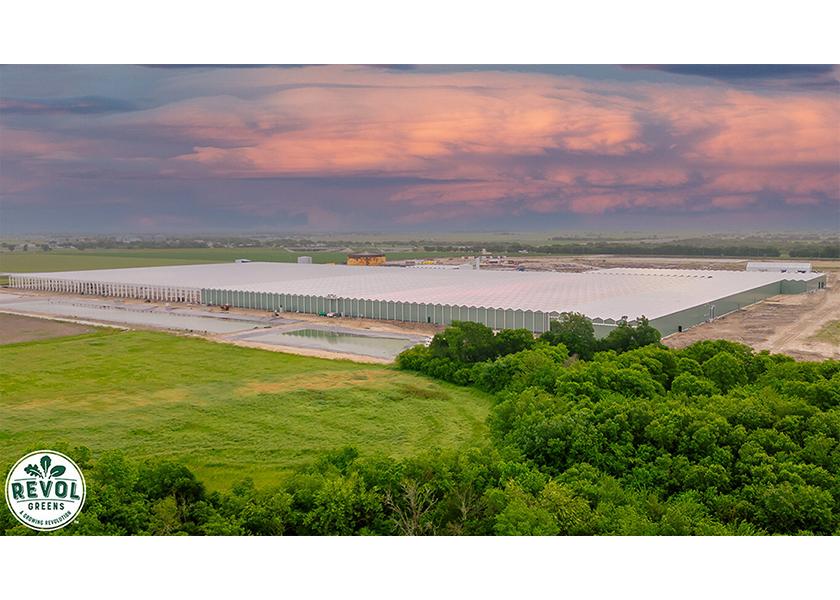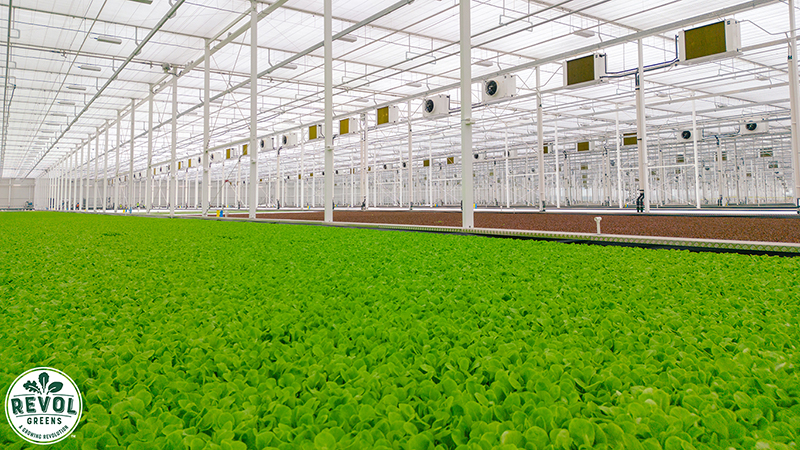Farming as a dance: How Revol Greens' VP of operations grows greens in Texas

Scanning a sea of tender baby arugula, tatsoi and red leaf lettuce stretching up toward filtered sunlight, for a moment I forgot that I wasn’t in Salinas. Far from America’s Salad Bowl, I was, in fact, in a greenhouse right in the middle of Texas, about 60 miles north of Austin, in a region known more for its barbecue than fresh produce.
Earlier this year in May, Revol Greens cut the ribbon on a 20-acre greenhouse in Temple, Texas, a sizeable footprint for a controlled environment agriculture lettuce operation by any measure. But the fact that the grower’s newest greenhouse was built in an area not known for growing greens was just another sign of Revol Greens’ audacious expansion plans.
I was lucky enough to spend the day touring Revol Greens’ newest greenhouse in Temple, Texas, with its vice president of operations and recent Texas transplant, John Carkoski. The Midwest native has grown with the young CEA company for three years and counting. Carkoski began managing Revol Greens’ Minnesota farm and, this spring, has been charged with leading the launch of Revol Greens' newest CEA farm facility in Texas.
What I learned watching the world from Carkoski’s measured, long-term view, was that while Revol Greens' Texas expansion was bold, it was also a part of a long chain of strategic decisions by the greenhouse grower, thoughtfully expanding the footprint of its CEA facilities to span the U.S.
Observing a wide swath of salad greens flourish under the carefully calibrated temperature, humidity and irrigation sensors of Revol Greens' greenhouse, I was beginning to understand the draw.
Interview edited for length and clarity.
The Packer: What brought you to Revol Greens?
Carkoski: I grew up in this industry. My dad was a farmer, and my grandfather was a farmer in Nebraska. My dad was a classically trained pianist and musician. He wanted to be a priest, then he met my mom and that went out the door. He realized you couldn't raise a family properly on a music teacher salary, so he went back in the wholesale business.
I tried to not work in produce, but I got pulled back into it.
Revol Greens reached out to me right when COVID-19 really started with the shutdown, and they were expanding their Minnesota operation from 2.5 acres to 10 acres. I knew one of the guys that came over to Revol Greens — he and I had met before on the wholesale side — he said, "Hey, John, we need somebody like you to help facilitate this growth." So, I came on, ran the Minnesota facility for three years and then recently got promoted to VP of operations. I now oversee all the greenhouses, including this one in Temple that we just started in the past few months.
Could you share some of the factors that led to building your next greenhouse in Temple, Texas?
The population is a big part of why we chose Temple. It’s in the middle of the Dallas-Houston-Austin-San Antonio triangle. It’s one of the most populated areas in the country, so that gives us the ability to reach so many people.
So being able to service these customers, but [it] also complements our other greenhouses in California, Georgia and Minnesota — it's in the middle.
It sounds like you’re building a nationwide coverage strategy.
Our greenhouses are not right next to each other, so strategically as we look across the country, we can say, "OK, we have a place here that can service this, we have a place here that can service that," and you can start to see that overlap of who's going to service which different areas in which other major metropolitan areas.
How did your team design your facilities to withstand the brutal Texas heat and still be profitable?
Our greenhouse is a climate-controlled facility. When you drove into a facility here you drove by that massive water tank. As far as I understand, that is the largest cold water storage tank in the world.
This facility is designed to withstand as much of the heat as possible; it's really meant to really cover all the averages. We have excess cooling and ventilation on the roof. We have a computer control system and climate system that's constantly monitoring and adjusting our growers and putting their inputs into what they want to see in different areas, and along with the cooling system, it will allow that to go through and control the different areas and departments to get into the climate that we need.
That’s impressive. Does the water tank also reduce your overall water usage?
We have a water catchment system throughout the entire greenhouse, and you can see the ducting coming outside of the building. Across entire greenhouse, any rain on the on the roof is get collected and gets pumped for a water storage. The water goes through a UV filtration system to clean it and sanitize, and then from there it goes into our ponds and our growing systems and then internally we have water recirculation. We’re constantly recirculating that water throughout our facility. What that means is that we can grow with 90% less water than outdoor conventional practices.
When do you harvest the lettuce?
It depends on the variety. It's a constant harvest — we're seeding, growing and harvesting 365 days a year. It's a constant cycle.
How do you manage the 365-day harvest and how does the Texas facility fit into the bigger picture at Revol Greens?
It really comes down to planning. I always make the analogy: We try to get to "Groundhog Day" — you know, the Bill Murray movie? We want to wake up and it's the same thing every single day. We want to seed and pack the same way, making only slight changes. The goal is to create the same cadence every day.
I love that! It sounds like the recipe for an efficient operation: make a good use of everyone’s time and see what your operation is capable of.
We work with our growers so that we have a constant flow of the same amount. We're having to get that feel part of it — we are getting the operation to be as effective as possible.

I imagine it must be satisfying to lead operations when everything is in sync.
It is. It's impressive. And the most impressive thing is that this facility is going to be doing in about two months what it took us about three years to do in Minnesota.
It's so cool to see our employees witness what's happening, and they're getting confident in their practices. They're understanding what's going on, and [it's the] same with our growing team; it's just it's amazing to see it all come to fruition.
Looking ahead, what are you hoping to see happen? Any challenges you see coming down the pike?
For this particular farm facility, we still have to learn the facility and how it responds to changes in weather and changes in our internal climate. In Minnesota, we have a very good feel for that facility because we've been there for so long.
Here, we're still trying to figure out exactly what it's going to look like in two months and in three months. We’re still gaining this knowledge, but I'm excited because, to me, that's an exciting challenge that we’ll figure that out as a team. It is a very fun dance.







